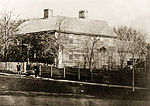Bennington, Vermont
Bennington, VermontCounty seats in VermontMicropolitan areas of VermontTowns in Bennington County, VermontTowns in Vermont ... and 1 more
Use mdy dates from July 2023

Bennington is a town in Bennington County, Vermont, United States. It is one of two shire towns (county seats) of the county, the other being Manchester. As of the 2020 US Census, the population was 15,333. Bennington is the most populous town in southern Vermont, the second-largest town in Vermont (after Colchester) and the sixth-largest municipality in the state. The town is home to the Bennington Battle Monument, which is the tallest human-made structure in the state of Vermont. The town has a long history of manufacturing, primarily within wood processing. The town is also recognized nationally for its pottery, iron, and textiles.
Excerpt from the Wikipedia article Bennington, Vermont (License: CC BY-SA 3.0, Authors, Images).Bennington, Vermont
Eastview Drive,
Geographical coordinates (GPS) Address Phone number Website Nearby Places Show on map
Geographical coordinates (GPS)
| Latitude | Longitude |
|---|---|
| N 42.891111111111 ° | E -73.208055555556 ° |
Address
Mt Anthony Country Club
Eastview Drive
05257
Vermont, United States
Open on Google Maps









